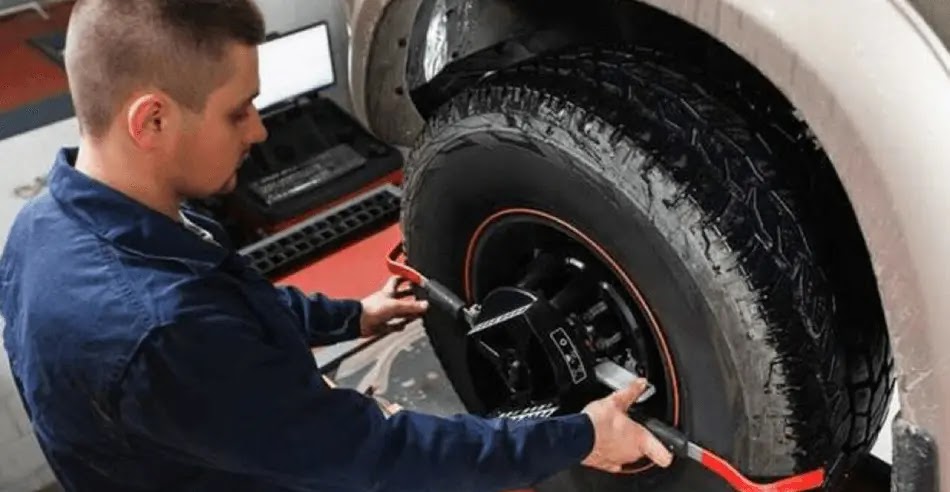With a proper wheel alignment, the tires last longer and fuel consumption is reduced. If you notice uneven or unusually fast tire wear, or vibrations when driving, if the vehicle pulls in one direction, or if the steering wheel is not completely straight, then it may be a sign that the wheels are not set correctly. we explains how to diagnose a bad wheel alignment and correct the simplest and most common problems at home.
Prepare the wheel alignment
- Tire pressure. Before proceeding to the wheel alignment, it is important to check that the tires have a correct and even pressure. If the tire pressure is not optimal, it may be the cause of the uneven tire wear and a side effect of this may be that the car pulls to one side or that it does not drive completely straight. If you check this first, you can avoid performing the wheel adjustment. Correct tire pressure is important if you want to get accurate measurements longer in the wheel alignment.
- Car manufacturer's instructions. Check the owner's manual for information on correct wheel settings. You should find numbers that describe the car's ideal toe, camber and caster. Write down the numbers. Here you can read more about what the values mean.
- Suspension and shock absorbers. If the parts on the wheel damping are worn, it can also cause problems with the steering or tire wear. To check the suspension, drive the car out on a flat surface, use a jack , lift the car and place it on a shoulder stand. Make sure the steering wheel is not locked. The easiest way to check the suspension when the car is raised is to shake each wheel in all directions. If you do not feel any movement, the damping is probably in good condition. If it feels loose, replace the worn parts. This also applies to ball joints, bearings, etc. Remember to hoist the car down as the car must stand with the wheels on the ground when measuring the position of the wheels.
TIP
- Modern adjustment machines used in professional workshops provide the most accurate measurement and adjustment of the car's wheel alignment. It is important to note that the car is not completely horizontal and that the front wheels are not mounted on turntables, so you will not be able to measure the angles of the wheels to 100%.
- In addition to the camber and toe, there is a third measured value called a caster. Caster means the angle of the guide pin in degrees. Caster is very difficult to measure without special tools and it is almost impossible to adjust at home.
- For many cars, you can not even adjust the caster without replacing the suspension. If the problem is not fixed when correcting the toe angle, you should probably perform a caster adjustment. This means that you must visit an authorized workshop.
Warnings
- When using a jack to lift the car, it should be stable before you start shaking the wheels to check the suspension. It is not uncommon for accidents to occur where amateur mechanics get trapped under the vehicle and the consequences are usually very serious. Therefore, use only suitable lifting equipment and always place the car on proper axle stands.
- Remember that wheel settings on modern cars consist of several angles and measurements that are independent of each other and they only work optimally if they are adjusted together. If the adjustment is incorrect, the steering and handling of the car can be significantly affected and this can put you in dangerous situations. If you feel unsure, only carry out the wheel alignment at an authorized workshop.
How to measure toe
Toe settings affect, among other things, the car's characteristics in turns. Toe is the angle that the tires have seen from above and it shows if they are pointing outwards or inwards. Incorrect toe adjustment is the most common problem with wheel settings and it is easy to adjust on your own.
- Correct then. If the front part of the tires points inwards, towards each other, it leads to understeer in turns and the tires wear on the outer edges. This is called toe in. If the front of the tire points outward, away from each other, they cause oversteer in turns and cause wear on the inside of the tires. This is called toe out. Depending on which car you have, the owner's manual probably recommends zero toe-toe (even distance between front and rear) or light toe-in, which increases stability.
- Draw a line in the middle of the tire tread. Lift the car. Use chalk or a white pencil and hold it towards the center of the pattern while the car is still on the jack. Hold your hand very still and ask someone to spin the tire a full turn so that you draw a line around the circumference of the tire. Do the same on the other side.
- Lower the car. After the car is on the ground, push it down above each wheel a few times so that it is stable. Then push the car 3-4 meters forward with the steering wheel unlocked to ensure that the wheels are straight.
- Use a string and check the distance by stretching the string between the lines on the front of the tire. Repeat the process on the back.
- Compare the measurements. If the distance on the front is shorter than the back, you have a toe-in. If the distance at the back is lower, you have a toe-out. If they are identical, you have zero toe.
The rear toe is also important for control and tire life. It is also important that the front and rear tires are in line with each other. You can measure the rear toe in the same way as you measured the front tires. If the rear toe angle is not straight, ask a professional mechanic for help. The rear toe angle should be adjusted before adjusting the front toe angle. If you discover an incorrect setting on the rear tires, do not spend time adjusting the front toe on your own.
Adjust your toe
If you have not done this before and have not been trained in the process, you should be prepared that it will take some time to get it right:
- Find the ends of the steering joint. This is the connection between your steering system and your wheels, and they are L-shaped parts that are easy to find if you look closely inside the wheels.
- Loosen the lock nut. Between the ends of the guide joint and the guide joint, there is a nut that links the parts together and holds them in place. Release it with a wrench. Note that on some vehicles the lock nut on the driver's side can be threaded counterclockwise, while on the passenger side it can be threaded clockwise.
- There may also be a clamp that must be removed at each end to ensure that the gaiter is not pressed against the inner guide joint. Check this in the car's owner's manual.
- If it has been a long time since you performed a wheel adjustment, some parts may be difficult to loosen and you may need to lubricate them with e.g. WD40 .
- Adjust then. Depending on the type of steering you have, there are two ways to adjust the toe:
- 5.1. If you have rack-and-pinion steering, adjust the toe in and toe out by turning the inner guide joint.
- 5.2 If you have so-called “parallelogram control”, there is an adjustment sleeve that you need to turn to adjust the toe. These can be easily damaged in the process so be careful.
- No matter what system you have, remember that changes you make to the toe will be distributed between both wheels. Each steering joint must be adjusted to half of the desired change in or out.
- Check the toe angle again as described above. Adjust if necessary.
- Test drive the car. If you notice vibrations or the car pulling in one direction, you should check the setting again. If you can not fix it yourself, contact an authorized workshop.
How to measure camber
Camber is designed so that the tire is flat against the ground even in turns. Camber can be checked by measuring the vertical inclination of the wheels when the car is seen from the front. How to measure:
- Find the right camber. Positive camber is when the upper part of the tire slopes away from the car. In this case, the tires are usually worn on the outside. Negative camber is when the upper part of the tire is tilted inwards. In this case, the tires usually wear on the inside. Depending on which car you have, the manual probably recommends weak negative camber as this increases stability.
- Make a measurement triangle. Take a piece of hard cardboard or wood and cut out a perfectly straight triangle (at a 90 degree angle) that is the same height as your wheels.
- Make the measurements. Position the triangle perpendicular to the car wheels at a 90-degree angle to the center of one of the wheels. There will probably be a gap between your triangle and the tire, probably at the top. Measure the gap between the tire and the linear triangle. This is your camber. Repeat on the other front wheel. Both gaps should be approximately the same and within the range specified in the owner's manual. If this is not the case then maybe you need to make a wheel alignment. Repeat the same process on the wheels on the rear axle.
- If you think you have an incorrect camber angle, you can move the car forward or backward so much that the wheels turn half a turn, and then perform the measurement again.
Camber affects the ability to handle the car. It is unlikely that the camber angle is seriously wrong in terms of what it should be if you have not been in a serious accident. If the camber angle needs to be adjusted, do this before adjusting the toe angle.
You can usually not adjust the camber at home because you need special tools. For some cars, it can not even be adjusted. If you do not have experience with this type of work and professional tools, do not try to adjust your camber on your own.
Read more:
1. How to test your alternator: TROUBLESHOOTING
2. Signs of damping problems and simple repairs you can do yourself








